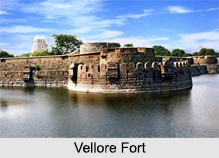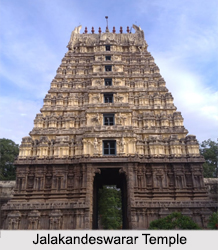 Vellore Fort is an ancient Indian fort located in Vellore district of Tamil Nadu. It was constructed by Vijayanagar rulers during the 16th century. The fort served as the headquarters of the Aravidu Dynasty which ruled the Vijayanagar Empire in Southern India. It was renowned for its majestic walls and ramparts, broad moat and masonry. Vellore Fort was occupied by several rulers from different dynasties, such as the kings of the Vijayanagara Empire, the Bijapur Sultans, Maratha Empire, the Nawabs of Arcot and the British East India Company. Tipu Sultan of Mysore was held captive in the prison cells of the fort during the rule of the British. The British Empire in India controlled the fort until the Indian independence in 1947. At present Vellore Fort is managed and maintained by the Archaeological Survey of India. The Fort consists of a temple for Hindus, a mosque for Muslims and a church for Christians.
Vellore Fort is an ancient Indian fort located in Vellore district of Tamil Nadu. It was constructed by Vijayanagar rulers during the 16th century. The fort served as the headquarters of the Aravidu Dynasty which ruled the Vijayanagar Empire in Southern India. It was renowned for its majestic walls and ramparts, broad moat and masonry. Vellore Fort was occupied by several rulers from different dynasties, such as the kings of the Vijayanagara Empire, the Bijapur Sultans, Maratha Empire, the Nawabs of Arcot and the British East India Company. Tipu Sultan of Mysore was held captive in the prison cells of the fort during the rule of the British. The British Empire in India controlled the fort until the Indian independence in 1947. At present Vellore Fort is managed and maintained by the Archaeological Survey of India. The Fort consists of a temple for Hindus, a mosque for Muslims and a church for Christians.
History of Vellore Fort
Vellore Fort was founded in 1566 AD by Thimma Reddy Nayaka and Chinna Bommi Nayaka who were rulers under Sadasiva Raya of the Vijayanagar Empire. The fort became strategically significant after Chandragiri became the 4th capital the Vijayanagar Empire.
Vellore Fort under various Rules
During the 17th century, the Aravidu Dynasty who held the title of Rayas occupied this fort. It was utilized as a military base during the Battle of Toppur in the early 1600s. The Rayas also fought against the Bijapur Sultans and the Nayakas of Madurai.
Vellore Fort was later seized by the army of Bijapur during the 1640s, under the rule of Sriranga Raya III. However, it was re-captured with the assistance of the Nayakas of Tanjore. In 1614, the royal family of ruler Sriranga Raya was slaughtered in the fort by the contending groups of the royal family. However, Rama Deva Raya, the younger son of the king, managed to survive. These resulted in the Battle of Toppur in the year 1616. Eventually the Sultan of Bijapur gained control over Gingee Fort as well as Vellore Fort.
 After a period of almost 20 years, Vellore Fort was captured by the forces of the Maratha Empire. The fort was modified and the fortifications were improved under the reign of Emperor Shivaji. The fort remained under the Marathas from 1678 to 1707. Later in 1707, the fort was captured from the Marathas by Daud Khan Panni who was commander of the Mughal Army during the reign of Emperor Aurangazeb. The Mughal Dynasty occupied Vellore Fort from the year 1707 to 1760, after which it was captured by the British Empire in India. It was utilized as a prominent British garrison. During the Second Mysore War, Hyder Ali besieged the fort in 1780. However the British garrison maintained their stance for more than 2 years and the siege removed.
After a period of almost 20 years, Vellore Fort was captured by the forces of the Maratha Empire. The fort was modified and the fortifications were improved under the reign of Emperor Shivaji. The fort remained under the Marathas from 1678 to 1707. Later in 1707, the fort was captured from the Marathas by Daud Khan Panni who was commander of the Mughal Army during the reign of Emperor Aurangazeb. The Mughal Dynasty occupied Vellore Fort from the year 1707 to 1760, after which it was captured by the British Empire in India. It was utilized as a prominent British garrison. During the Second Mysore War, Hyder Ali besieged the fort in 1780. However the British garrison maintained their stance for more than 2 years and the siege removed.
During the Vellore Mutiny, the fort played a major role. In 1806, Vellore Fort was used to post infantry units of the Madras Regiment. The native soldiers attacked Vellore Fort on July 10, 1806 and killed several European officers. The British Empire in India possessed the fort until the country achieved freedom in August 1947.
Architecture of Vellore Fort
Vellore Fort is known for its military architecture. Vellore Fort was built with granite gathered from the mines in Chittor and Arcot districts. It covers a total area of 0.54 sq km (133 acres) and is situated at a height of 220m. The entire fort is enclosed by a broad moat that was originally used as a line of defence during invasions. It also consists of a tunnel that was used by the king and other members of the royal family to escape during enemy attacks. The tunnel opens up 12 km away in Virinjipuram. The fortress also includes majestic ramparts and robust masonry. Vellore Fort displays the ingenuity of the rulers in the military and strategic architecture in South India.
Monuments in Vellore Fort
Vellore Fort also includes several other structures, such as, a Church, a Mosque, a Temple, a Christian Hospital and various buildings which are currently utilised as public offices. The temple is known as Sri Jalakandeswarar Temple and is devoted to the deity Jalakandeswarar, an embodiment of Lord Shiva. The mosque inside Vellore Fort was built during the reign of the last Nawab of Arcot. A church was founded during the rule of the British East India Company. The church in the fort is called St John"s Church. Built in 1846, it is the oldest church in Vellore Diocese. There is also a memorial known as "Muthu Mandapam".
At present, a multi-purpose Government Museum has been established in Vellore Fort which is maintained by the Department of Museum Government of Tamil Nadu. Currently the fort is developed as a tourist destination in Vellore and is maintained by the Archaeological Department of the Government of India.



















